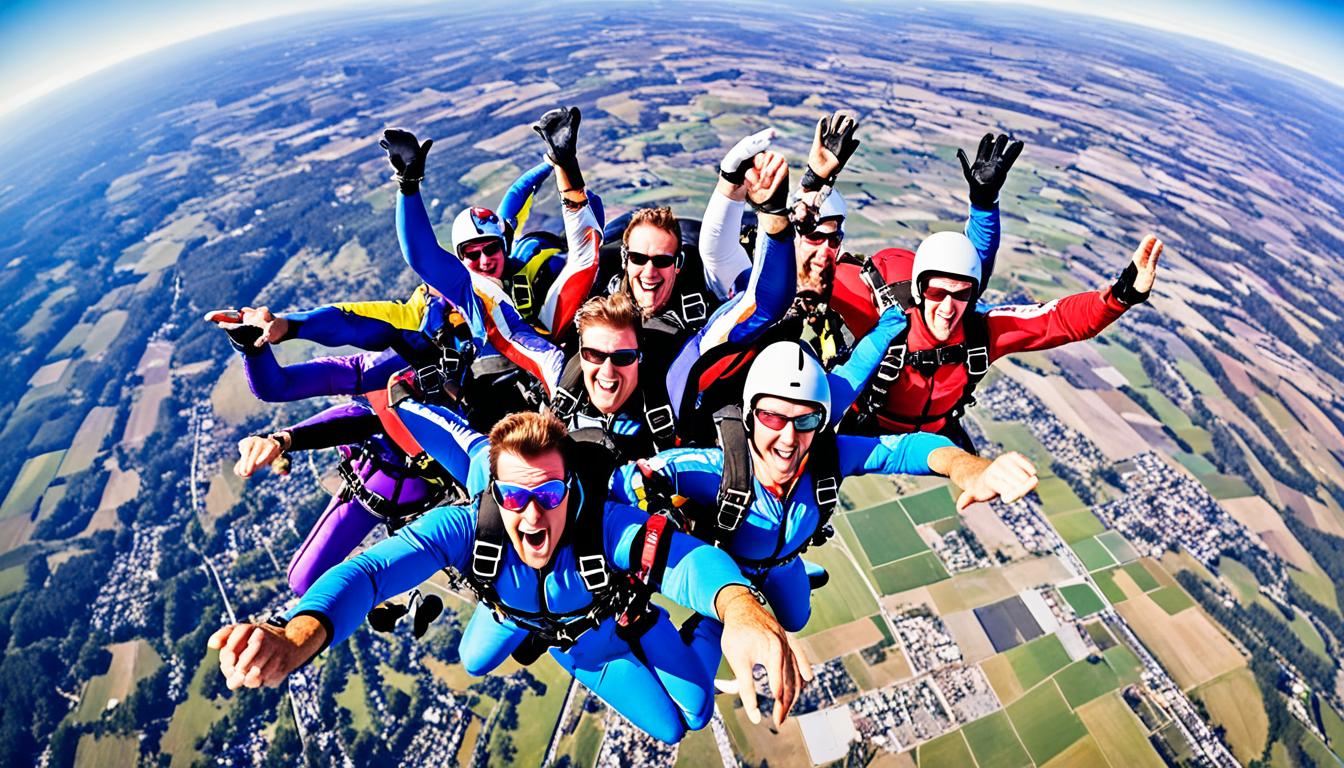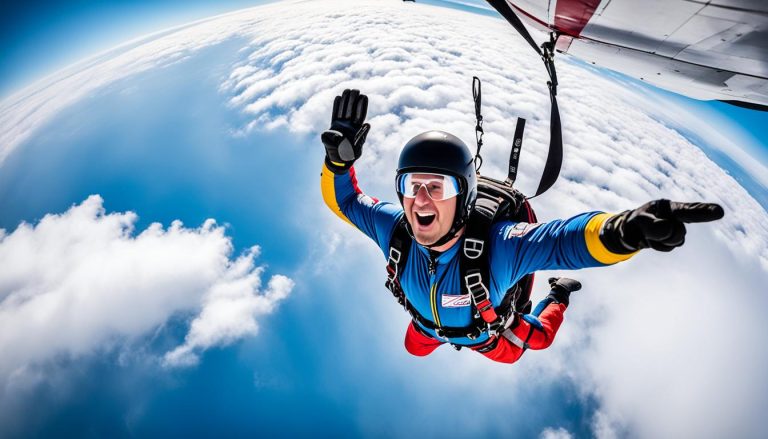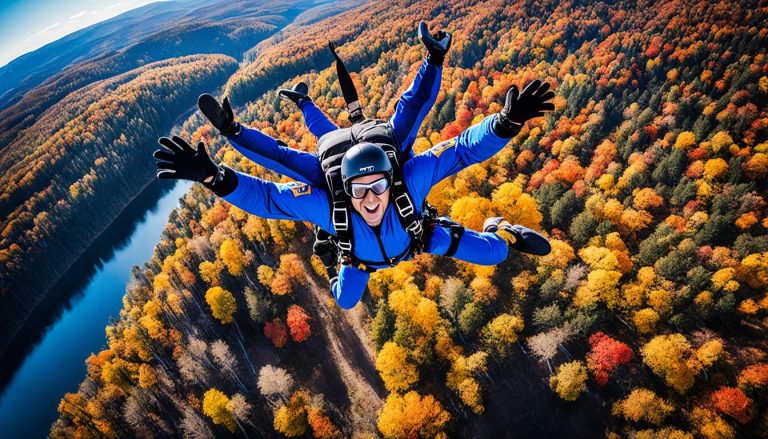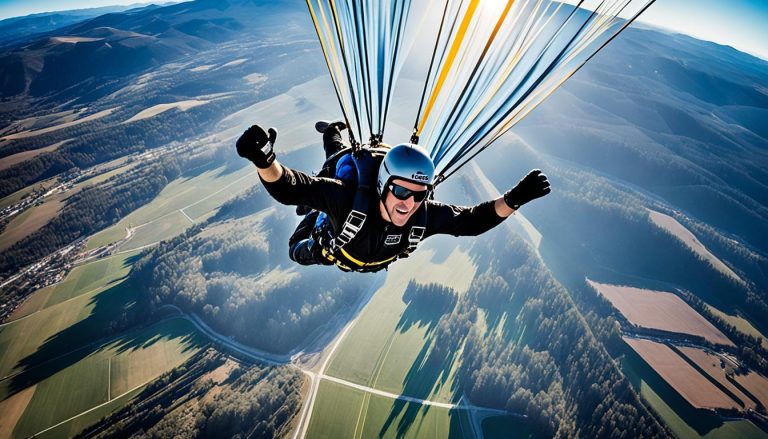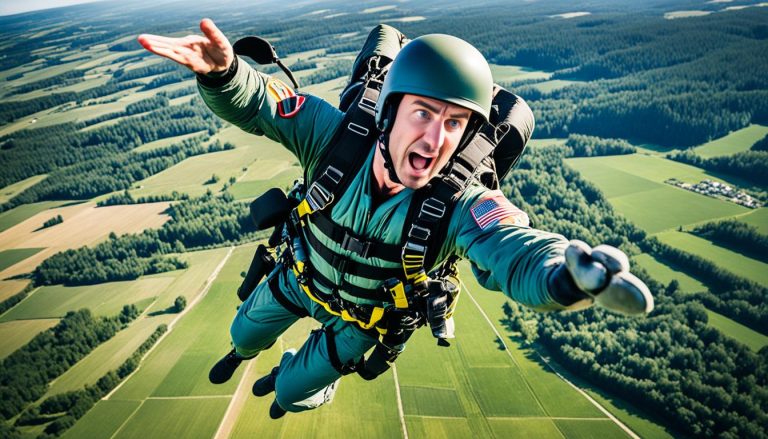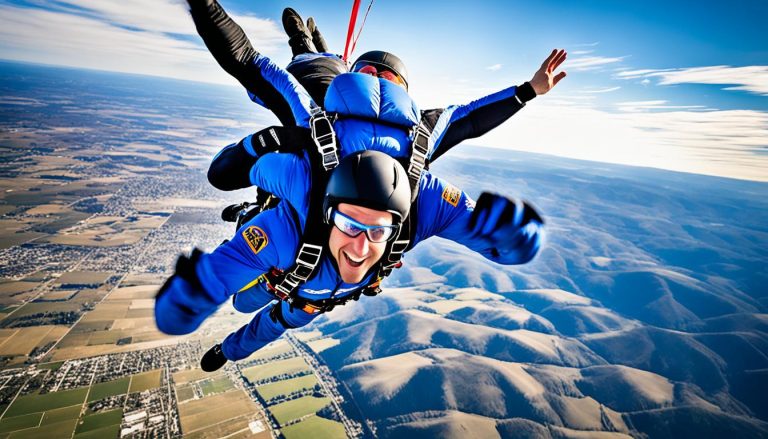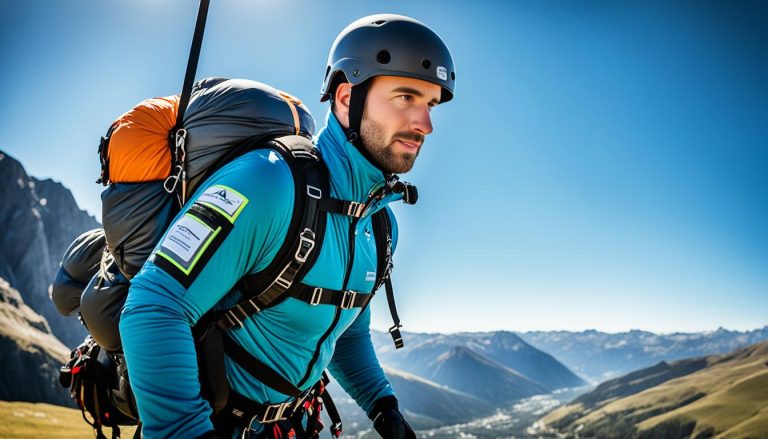Parachuting Lingo: Understanding the Jargon of the Sky
The vocabulary of skydiving goes beyond the word “parachute” and encompasses a whole world of terms and expressions. Whether you’re a seasoned skydiver or just starting out, understanding the jargon and terminology used in the world of skydiving is essential. It not only helps facilitate clearer communication between skydivers but also enhances safety and ensures a more enjoyable experience in the sky.
In this comprehensive guide, we will take a deep dive into the skydiving language, covering everything from basic skydiving terms to more specialized jargon. By the end of this article, you’ll be equipped with the knowledge to navigate the world of skydiving lingo like a pro.
From understanding terms like AAD (Automatic Activation Device) and AFF (Accelerated Free Fall) to familiarizing yourself with the significance of an altimeter and the stable body position known as “arch,” we’ll cover it all. Dive into the captivating world of skydiving with us as we explore the fascinating language and terminology that accompanies this thrilling sport.
AAD – Automatic Activation Device
The AAD, or Automatic Activation Device, is a technologically advanced system in skydiving that deploys a reserve parachute at a predetermined altitude when a skydiver is descending at a high rate of speed. It is a crucial safety device that has saved many lives by deploying the reserve parachute when necessary.
The Automatic Activation Device (AAD) is a skydiver’s guardian angel, ensuring their safety during a jump. This ingenious device acts as a failsafe, automatically deploying the reserve parachute when needed. It is designed to activate at a specific altitude to prevent fatalities or serious injuries in case the skydiver fails to deploy their main parachute in time or encounters an emergency situation.
The AAD works by constantly monitoring the skydiver’s descent rate and altitude. If it detects a rapid descent below a certain threshold, indicating a potential life-threatening scenario, it triggers the reserve parachute deployment. This technology has significantly increased skydiving safety by providing an additional layer of protection and preventing fatal accidents.
The AAD is like a silent guardian in the sky, ready to spring into action when needed. It is an invaluable device that has saved countless lives in the world of skydiving.
Equipped with sophisticated sensors and state-of-the-art algorithms, the AAD ensures precise and timely altitude deployment of the reserve parachute. This crucial safety mechanism is a game-changer for both novice and experienced skydivers, ensuring they have a backup option in case anything goes wrong with their main parachute.
The AAD is a mandatory piece of equipment for professional skydivers and is highly recommended for all skydiving enthusiasts. It provides peace of mind, knowing that there is an automatic safety net in place, ready to activate if needed.
How the AAD Works
The AAD operates on a set of predetermined parameters determined by the manufacturer and the individual skydiver’s preferences. These parameters include the activation altitude, velocity thresholds, and free fall time allowances. Skydivers can adjust these settings to suit their specific needs and preferences while ensuring adequate safety measures.
When the AAD detects a rapid descent rate and altitude below the activation threshold, it initiates a sequence of actions to deploy the reserve parachute. This series of actions typically includes a cutter, which cuts the closing loop of the main parachute container, followed by a pilot chute deployment to extract and deploy the reserve parachute.
With the AAD as their guardian angel, skydivers can focus on the thrill and joy of free fall, knowing that their safety is in capable hands. This technological marvel has revolutionized skydiving safety, giving skydivers an added sense of security.
Benefits of the AAD
- Enhanced Safety: The AAD provides an additional layer of safety by automatically deploying the reserve parachute at a predetermined altitude.
- Reduced Risk: The AAD significantly reduces the risk of fatalities and serious injuries in case of skydiving accidents or emergencies.
- Peace of Mind: Skydivers can enjoy their jumps with the confidence that an advanced safety device is constantly monitoring their descent and will activate the reserve parachute if necessary.
- Wide Applicability: The AAD is suitable for skydivers of all experience levels, from beginners to professionals, ensuring safety for everyone.
Entering the world of skydiving is an exhilarating experience, but safety should always be a top priority. The AAD, with its automatic activation and reserve parachute deployment, is a game-changing device that demonstrates the commitment of the skydiving community to safety and innovation.
| Benefits of the AAD |
|---|
| Enhanced Safety |
| Reduced Risk |
| Peace of Mind |
| Wide Applicability |
AFF – Accelerated Free Fall
AFF, or Accelerated Free Fall, is a highly sought-after method for those looking to learn to skydive. It is widely recognized as the most popular training program for first-time skydivers around the world. this is what allows them to experience the thrill of a full minute of free fall from an altitude of 14,000 feet, all under the careful guidance of experienced instructors.
This method provides a more extensive free fall experience compared to traditional static line training. Rather than being attached to an instructor, AFF students jump solo from the aircraft, wearing their own parachute system and deploying their own main canopy. However, they are not alone in this endeavor. Throughout the skydive, two instructors accompany the student diver, one on either side, ensuring proper body position, stability, and safety.
During the AFF program, students progress through a series of training levels, with each level building upon the skills learned in the previous one. The curriculum covers fundamental aspects of skydiving, including body positioning, free fall maneuvers, altitude awareness, canopy control, and emergency procedures.
Why Choose AFF?
There are several reasons why aspiring skydivers choose the AFF training method:
- Increased free fall time: With AFF, students get the opportunity to experience a longer free fall, allowing them to refine their body movements and build confidence in the air.
- Gradual independence: AFF offers a progressive learning approach that allows students to gradually take on more responsibility during each jump, building their skills and confidence incrementally.
- Tandem jump exemption: Students who complete the AFF program are typically exempt from the tandem skydiving requirement often imposed by dropzones for future jumps.
By choosing AFF, students can fast-track their journey toward becoming licensed skydivers, while also enjoying the thrill of longer free fall experiences. It’s the perfect training method for those seeking a more immersive and independent introduction to the world of skydiving.
“AFF is an exceptional training program that delivers an unparalleled free fall experience and a comprehensive skillset for future skydivers. It’s the gateway to becoming a licensed skydiver and opens up a world of opportunities in the sky.” – Experienced AFF Skydiver
The AFF Program at XYZ Skydiving Center
If you’re ready to take the plunge and experience the excitement of an Accelerated Free Fall, XYZ Skydiving Center offers a top-notch AFF program led by highly qualified instructors with years of experience. Our comprehensive training ensures that you receive the knowledge and skills necessary to become a confident and competent skydiver.
Throughout the program, you’ll complete a series of training levels, each designed to develop specific skydiving skills. Our instructors will provide detailed briefings and debriefings for each jump, offering valuable feedback and guidance to help you progress successfully.
At XYZ Skydiving Center, your safety is our top priority. We adhere to the highest industry standards and maintain state-of-the-art equipment to ensure a safe and enjoyable skydiving experience for all AFF students.
Join us at XYZ Skydiving Center and embark on an unforgettable journey as you learn to skydive through our acclaimed AFF program.
A-License – First Rating for New Skydivers
The A-License is a significant milestone for new skydivers, as it signifies their readiness to take on solo jumps and explore different dropzones. This license allows skydivers to experience the thrill of solo skydiving and join the community of experienced jumpers.
To earn an A-License, skydivers must meet specific requirements set by the United States Parachute Association (USPA). These requirements ensure that the skydiver possesses the necessary skills and knowledge to engage in safe and enjoyable jumps.
The USPA sets the following criteria for obtaining an A-License:
- Complete a minimum of 25 jumps
- Pass written exams covering various aspects of skydiving, including equipment, safety procedures, and emergency protocols
- Obtain a stamp from the USPA after successfully completing all the requirements
These requirements help skydivers develop the skills needed to perform controlled exits, maintain stability during free fall, and deploy their parachutes accurately.
During the progression towards an A-License, skydivers learn essential skills such as canopy control, basic free fall maneuvers, and emergency procedures. Each jump provides an opportunity to refine these skills and build confidence.
Once skydivers obtain their A-License, they can enjoy the freedom of solo skydiving, join group jumps with other experienced skydivers, and explore new dropzones around the country.
Benefits of the A-License
Having an A-License opens up a world of possibilities for skydivers, allowing them to fully immerse themselves in the sport. Some key benefits include:
- The ability to jump solo and experience the full thrill of skydiving
- Opportunities to participate in group jumps and formations with other experienced skydivers
- Access to different dropzones and the chance to explore new skydiving locations
- The potential to pursue advanced skydiving disciplines and ratings
By obtaining their A-License, skydivers demonstrate their commitment to the sport and their dedication to maintaining safe practices in the sky. It is a proud moment that marks the beginning of an exciting journey as a licensed skydiver.
| Requirements | Minimum Quantity |
|---|---|
| Jump count | 25 jumps |
| Written exams | Passing grade on all exams |
| USPA stamp | Successful completion of all requirements |
Altimeter – Essential Equipment for Skydivers
An altimeter is a crucial piece of equipment used by skydivers to measure altitude during a jump. It provides accurate information about the skydiver’s position in the sky, ensuring safe and controlled descents.
Typically worn on the wrist, the altimeter is a compact device that enables skydivers to monitor their altitude throughout the jump. It consists of a dial or digital display that indicates the height above ground level.
The altimeter functions based on atmospheric pressure changes. As the skydiver ascends or descends, the air pressure alters, which the altimeter detects and converts into an altitude reading. This measurement is essential in determining the right time for deploying the parachute.
Every skydiver is required to jump with an altimeter as part of their essential equipment. It is a vital tool that allows them to stay within pre-determined altitude ranges, ensuring a safe landing. By monitoring altitude, skydivers can adhere to jump plans, freefall time limits, and deployment altitudes accurately.
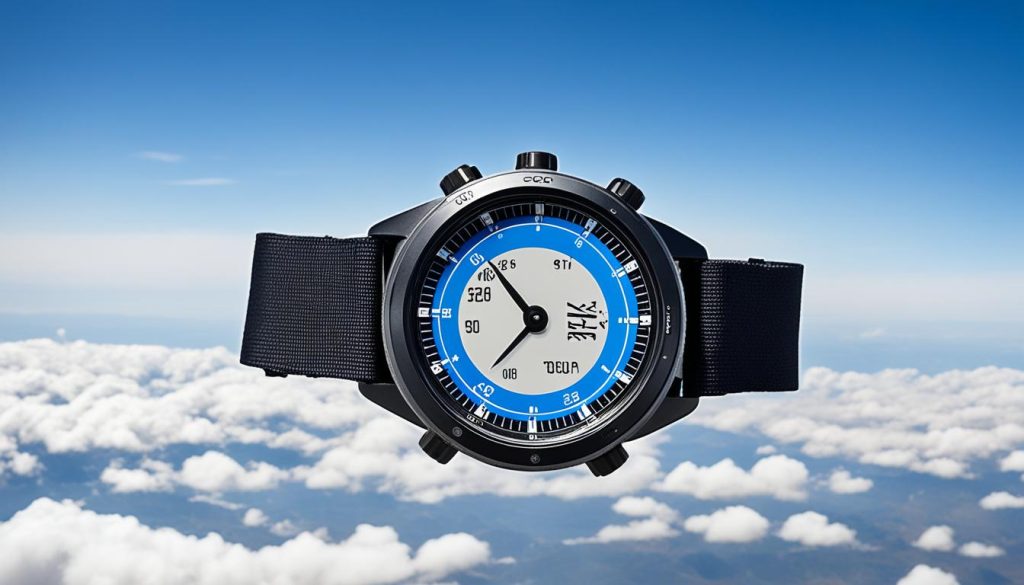
As shown in the image above, the altimeter is secured to the wrist with a strap, making it easily visible and accessible during the jump. The clear dial or digital display allows quick and accurate altitude readings, even at high speeds or under challenging skydiving conditions.
Arch – The Stable Body Position in Free Fall
When it comes to free fall technique, achieving a stable body position is crucial for skydivers. One of the key elements in maintaining stability during a free fall is the arch. The arch refers to a specific body position that provides the necessary balance and control for a successful jump.
To achieve the arch, skydivers must push their hips forward while bending at the lower back. This action helps to create a curvature in the body, resembling an arch shape. By doing so, the skydiver can distribute their weight evenly and maintain a streamlined body position, which minimizes unnecessary movements and maximizes stability.
The arch is essential for both beginner and experienced skydivers. It allows them to navigate through the air with precision and control. By mastering this technique, skydivers can maintain optimal stability even during challenging maneuvers.
“The arch is the foundation of stability in free fall. It’s like the backbone of a successful jump.” – Emily Johnson, professional skydiver
The arch not only provides stability but also enhances the overall free fall experience. By maintaining a stable body position, skydivers can fully immerse themselves in the thrill of the moment, enjoying the sensation of flying through the air. It also allows them to focus on other aspects of their jump, such as performing maneuvers or capturing breathtaking views.
Whether it’s a solo skydive or a formation dive with a team, mastering the arch is fundamental for every skydiver. It sets the stage for a safe, controlled, and exhilarating free fall experience.
Conclusion
Understanding the lingo and jargon of the skydiving world is essential for both new and experienced skydivers. By familiarizing themselves with terms such as AAD, AFF, and Altimeter, skydivers can enhance their safety, improve communication, and increase their overall enjoyment of the sport.
Mastering the language of skydiving allows participants to fully immerse themselves in the thrilling world of parachuting. Whether it’s knowing the parachute terminology, skydiving slang, or freefall terms, being fluent in the jumping vocabulary enhances the skydiving experience.
So, if you’re a skydiving enthusiast or someone considering taking up this exhilarating sport, don’t skimp on learning the skydiving lingo. Embrace the parachute expressions, skydiving language, and canopy jargon, and let it be the language that connects you to the incredible community of skydivers around the world.

